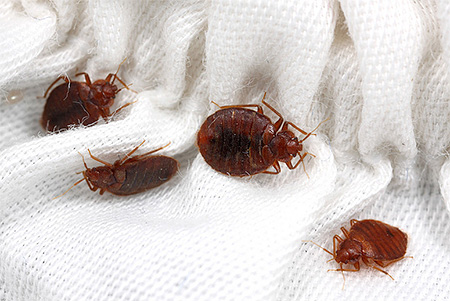
The appearance of homebugs, their lifestyle and way of eating well distinguishes them from all others. domestic insects. It is quite difficult to confuse these parasites with ants, cockroaches, or occasional guests of an apartment, and only by several signs even a resident of a big city or a small village very distant from entomology will be able to understand that before him is the most annoying night vampire.
And once he saw in the photo how homebugs look, and even more so - having met them in bed, it will be almost impossible to confuse them with other insects.
By the way, it is the peculiarities of life and biology that the home bug can boast, not only facilitate the task of identifying it, but also complicate the struggle with it. It is the indifference of bedbugs to the quality of the room, their ability to settle in quite restless places (no cockroach can feel comfortable under the bed mattress),resistance to many insecticides and some other qualities dictate certain rules of the game, only by observing which bugs and can be expelled from the premises.
But first you need to determine exactly what is before us a bug, and this will help us detailed photos ...
What do homebugs, their larvae and eggs look like?
Domestic bugs (bedding, furniture, sofa - not common synods) - small insects of dark brown color in the adult state and lighter, almost yellow - in the larval stage (see photo):
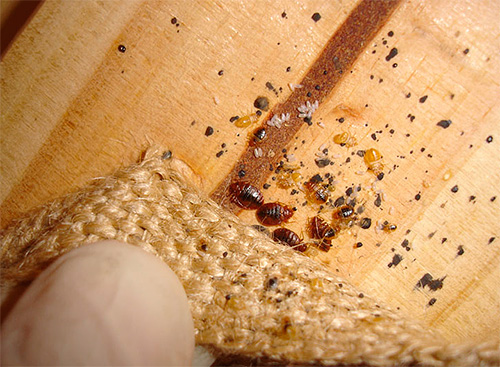
A characteristic feature of them is very wide in the sides, but at the same time flat from the back body. Externally, domestic bugs look like flattened cockroaches, but only until they get drunk. The flat insect body is clearly visible in the picture:
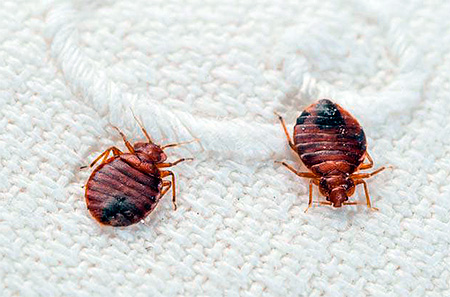
An important feature of these insects is also the absence of wings. Everything species of domestic bugs they are deprived of them, and by this they are well distinguished from most other representatives of the order of hemiptera — enemies of agriculture, water striders, and bug soldiers — whose wings form a particular body shape with noticeable angles and patterns.
For example, compare on the photo below what it looks like bedbug and the usual home bug:
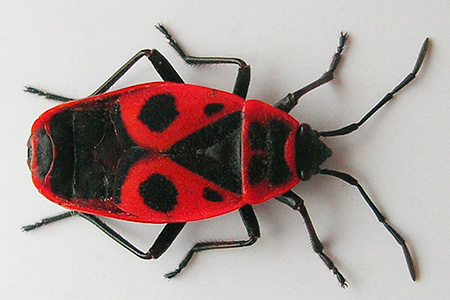

It is interesting
Scientifically refuted the statements of many witnesses who claim that the bugs are flying. In principle, they are not capable of doing this. And the facts of the fall of these creatures on the bed or a standing person are explained by the fact that insects quietly climb to the ceiling and, unable to restrain themselves, fall from there.
Such cases can occur with a very large number of parasites in the room, when they are hungry and trying to get to the food source in any way.
Due to the lack of wings in domestic bugs, the abdomen is clearly visible, divided into segments by transverse stripes. In adult insects, this separation is especially noticeable after they feed - their body stretches and thickens, and in general they become similar to the larvae of black cockroaches. In the photo you can see the difference between a hungry and a full insect:
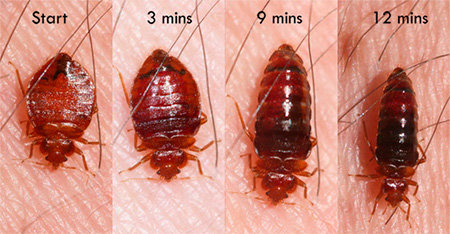
On a note
Talking about the varieties of domestic bugs is not entirely incorrect from a scientific point of view. There are about 30 species of bed bugs around the world, very similar in appearance and differing in the details of the structure, which can only be distinguished under a microscope.
But the representatives of the majority of these species do not interbreed with each other and do not produce fertile offspring. The photo shows adult individuals of some species - it can be difficult for a non-specialist to distinguish them from each other.
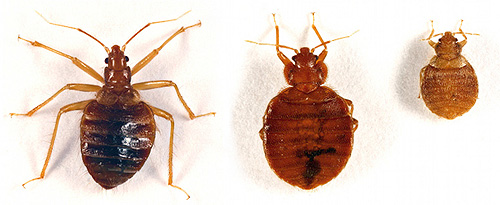
The size of domestic bugs is small: adult insects have a body length of 4 to 8 mm, depending on the degree of blood saturation, the size of the larvae ranges from 1 mm to 4 mm. The width of the body of an adult hungry bug is almost the same as the length. As you can see from the photo, the bug looks like a copper coin:

Bug larvae They are also called nymphs because they differ from adults only in size and color details. The hungry larva of the first three ages has a light yellow color, its chitinous integuments are transparent. Therefore, a droplet of blood in the stomach after a hearty meal becomes clearly visible in the body of the nymph (see photo):

Superficially bugs can be confused only with cockroaches. Both from black cockroaches and from Prusaks, these parasites are distinguished by the absence of two characteristic outgrowths at the end of the abdomen - cerok. In cockroaches and their larvae cerci are necessarily and clearly visible. The following photo clearly shows these outgrowths:
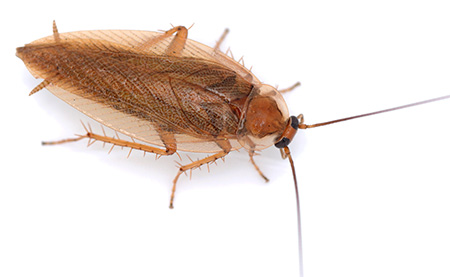
In addition, adult cockroaches have wings, although they do not use them for their intended purpose.
Domestic bugs have their own specific smell. It is especially active in females with a secret, which they attach eggs to different surfaces. For a person, this fragrance is a bit like the smell of fermented berries or brandy. The presence of this smell in the apartment is a clear sign of the strong infection of its parasites.
It is interesting
Compared to their relatives, domestic bugs smell very faint. Some of the bugs found in nature are among the most fragrant insects in general. Everyone knows the bugs, called "stinkers" by the people, the soldiers, who are not eaten by birds, the harmful turtles - they all have a very strong smell that helps individuals in communication and save them from predators.
But it’s only possible to speak about whether homebugs smell like: compared to ants or cockroaches, they smell much, compared to other hemiptera, not so much.
Bedbug eggs are small, about a millimeter in length, elongated and look like rice grains. At the end of them there is a small cap. All the details of the egg are clearly distinguishable in the photo:
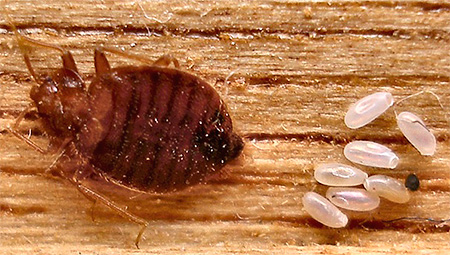
Such an egg, found lying apart from the colony, can be overlooked and confused with anything.
But female bugs they lay eggs mainly in shelters, and therefore there are clutches along with insect droppings, chitinous skins of nymphs and an abundance of parasites of different ages (see the example in the photo):
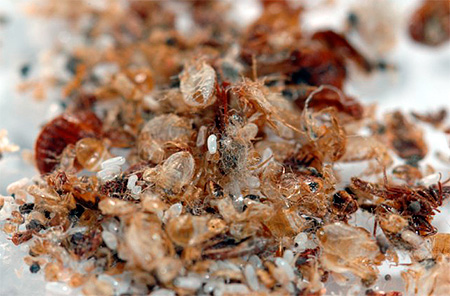
And in general, the reproduction of these insects occurs in the secluded places of the room.
Breeding domestic bugs
Bedbugs breed at amazing speeds. Even the ubiquitous cockroaches are inferior to them in speed of increase in numbers.
Each bug becomes sexually mature one month after hatching from the egg. The temperature of the room can affect the rate of maturation of the insect - at temperatures below 20 ° C the larva grows within two to three months. In general, these parasites are afraid of sudden changes in temperature, and they rarely settle in unheated premises in central Russia.
Domestic bugs die at temperatures below minus 22 ° C and above + 45 ° C. This use of disinfection services to deal with them, using industrial hair dryers for the treatment of individual premises.
Each female lays about 400 eggs in her entire life, about 3-4 eggs once a day.No concern for the offspring of bugs.
An important feature of breeding bed bugs is the so-called traumatic insemination, in which the male pierces the integument of the female's body with his sexual organ and inserts sperm into her abdomen. Agree, from our human point of view, this act looks rather shocking.
Eggs develop for some time in the female's body, and with a lack of food they can dissolve and serve as food.

Purely theoretically, according to the calculations of scientists, in six months the offspring of one female bug can exceed 1 billion descendants. Of course, there are no such numbers of insects in a real apartment, but still within a few months the bloodsuckers are able to breed so much that they make the room unfit for life.
Both adult domestic bugs (according to scientific - imago), and their larvae feed only on human blood. At the same time, when an adult insect bites, an analgesic is injected into the wound, and the person does not feel the bite itself.
The close-up photo shows how the bug bites:
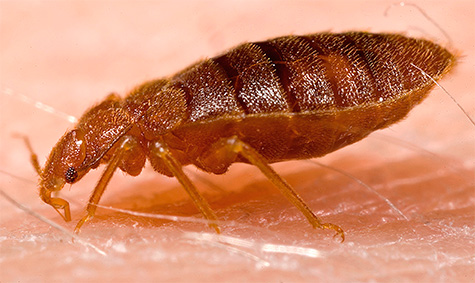
But the nymph does not yet have the ability to inject an anesthetic with a bite, and it is the bites of young bugs that particularly disturb a person in a dream.
Home bugs and other insects in the house: friends, enemies, or just neighbors
Relationships of domestic bugs with other inhabitants of human habitation are very difficult.
To start even from the owner himself - a person: because of the specifics of their diet, bugs are forced to bite themselves, and therefore their presence in an apartment is much more undesirable than the presence of, for example, cockroaches. Therefore, man destroys domestic bugs with a special tenacity.
But other insects in one way or another interfere with bugs:
- cockroaches willingly eat eggs of bugs. Even in spite of the fact that the habitats of these species of insects in a living room are different, nymphs of cockroaches often penetrate into colonies of bedbugs and harm eggs.
- The poison of domestic ants is deadly for bedbugs. In general, ants are distinguished by their peacefulness, and do not attack bugs by themselves. But the bugs will not be able to settle near the ant colony. In addition, ants, like cockroaches, are not averse to profit from the bug bug.
- Flycatchers, small centipedes of a very characteristic look, actively catch and eat bedbugs. They cannot completely destroy them in an apartment, but to a certain extent they can influence reproduction.However, due to the rarity of habitat in the apartments, the flycatcher cannot be used as a tool for biological control of bedbugs.
But bugs do not harm any other insects. They are not able to eat eggs or larvae, they do not compete with their neighbors for food. A sort of all offended altruists.
Interestingly, cats that love to hunt cockroaches are absolutely indifferent to bedbugs. Perhaps they are deterred by the smell of blood-sucking parasites. Other insects - moths, fleas, flies - just eat together with bedbugs.
Life bugs under the microscope
Domestic bugs settle indoors in a kind of elemental colonies-nests. There is no structure in such a settlement, but superficially it looks exactly like a colony due to the dense placement of imagoes, nymphs, eggs and insect waste products (see photo):
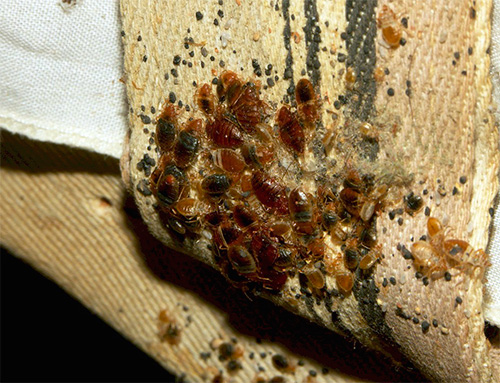
As a rule, these insects settle in any secluded places in the room in which a stable moderate temperature is maintained and which are located not far from the place of human rest.
Each bedbug eats with a certain frequency. Imago enough to eat once every five to seven days, the larvae suck blood almost daily.An adult female must eat very densely at least once in order to make one laying of eggs.
Each larva must shed five times before being transformed into an imago. It is the chitinous covers thrown off by the nymphs that form the garbage, creating a feeling of untidy whole nest.
The photo shows the chitinous integuments of the domestic bugs that they shed during shedding:
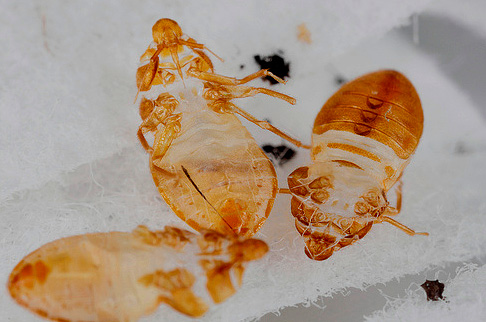
For one molt a nymph needs one full feeding, but more abundant food contributes to a better development of the insect.
If there is no food source nearby, or the temperature in the room drops sharply, insects can become numb, similar to the state of anabiosis. In this state, they can be up to one and a half years, and when a person appears next to them, they can leave it and return to normal life.
Domestic bugs are strictly night insects. They get out of their shelters and go in search of food in the period from 3 to 7 o'clock in the morning, when a person sleeps the most sound sleep. The rest of the time they spend in nests, which are located:
- in beds and upholstered furniture, under the mattresses
- under carpets and plinths
- behind the cabinets and inside them, behind the pictures on the walls
- in sockets
- inside the system units and various household appliances.
The photo below shows where to look for bedbugs in the apartment first of all:
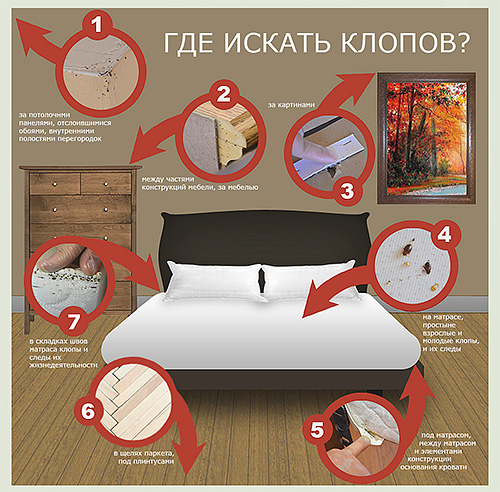
In such places it is necessary to look for bedbugs for the purpose of their destruction. However, the destruction itself must be carried out in view of the increased resistance of these insects to poison.
Resistance of bugs to various insecticides
Long evolution and high fecundity are the reasons why domestic bugs are more resistant to various poisons. Each individual insect dies from an insecticide just as quickly as a cockroach or an ant, but among a large number of descendants of one female, an individual with a mutation is likely to meet, thanks to which the parasite will be able to produce an antidote — a protein that neutralizes the insecticide in the body before it starts actions.
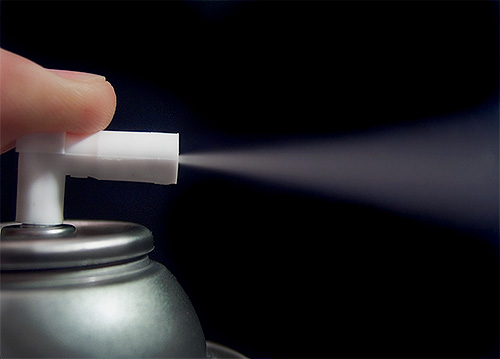
Under natural conditions, such mutations are not fixed in the species, since different poisons act on insects rarely. But when baiting bugs poison plays the role of a kind of factor of natural selection, which allows only mutants to survive.
Such resistant insects are found among the corpses of their brethren, give birth toalso resistant to poison, and a few months later, experts ascertain the ineffectiveness of a drug. It is important that the cause of the emergence of such resistant mutants is the man himself: the less parasites to poison, the less the likelihood of the emergence and fixation of the mutation.
On a note
Today, there are so many drugs on the market to which bugs (and other insects) can not develop resistance in principle. One example of such a drug is the anti-bed bug bug GEKTOR, effectively destroying even those populations of parasites that are insensitive to the traditionally used chemistry.
In this case, the key to the high efficiency of the agent is a specific mechanism of action - the active substance of the agent Hector is finely dispersed hydrophilic silicon dioxide, which can literally suck water out of bugs. Read more about this in a separate article: Insecticidal Hector.
It is important to take into account that a one-time treatment of the room even by an effective means often does not guarantee complete disposal of bedbugs: during baiting, eggs remain viable, from which later on the larvae are gradually removed.
Therefore, when using most insecticidal agents, it is recommended to treat the room twice with a break of five to six days in order to destroy all the larvae during repeated processing. To date, several very effective drugs have been developed that allow you to fight homemade bedbugs with your own hands. You can get acquainted with them in the relevant sections of this site.
What are the domestic bugs and how to recognize their presence in the apartment
Unique shots: pairing homebugs

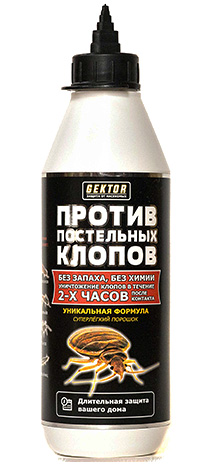
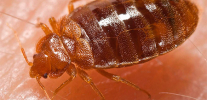

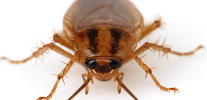
Hello! I have three small children, I am very afraid for them, the bugs so mercilessly bite them and me. I'm tired of bedbugs. And there is no money to buy poison or something. What do I do, I'm very tired. I do not sleep at night.
There is one and only opportunity to get rid of bedbugs - is to buy poison in the sanitary epidemiological station, and not somewhere in the store. Using a spray bottle, you can handle absolutely everything in the apartment, moving all the furniture that is in the apartment, especially carefully pour the upholstered furniture and plinth. Pour all the walls and floor. If there are carpets, then it is better to throw them away altogether, as you mess with them too much to process them (you need to sprinkle them with poison and close them tightly with plastic wrap). After processing in the apartment, close all windows and doors tightly and leave the house for a day. All clothes that are in the house should also be spattered with poison and, moreover, bed linen.
Such an operation should be carried out 3 times with a frequency of half a month.In this case, all bed linen washed in boiling water at 95 degrees and ironed. All neighbors must also process their apartments, preferably at the same time. There are no more ways to get rid of them. And most importantly - do not forget to carry out the treatment at least three times, since the larvae hatch, and everything starts all over again. And if only you poison, and the neighbors ignore, then the bugs will first run away to the neighbors, and then return to you.
Here, bought a prescription SES, 2 times hounded - and nifiga! Tsifoks this from cockroaches, and not from bedbugs.
Hello. Bought a garden, found dead bugs in the garden. Prior to this, two winters and one summer, no one was. Is it possible that the living remained? Thanks in advance!
Perhaps the period of anabiosis is 1.5 years without food.
Hello. Tell me, please, we have a little child recently born. After the maternity hospital, when we arrived, the bugs began to run. How can you get rid of them without causing special people?
Looks like nothing))
Please help me figure out the bugs. They are very small, very hard to see.Bred on the windowsill, crawling on curtains and curtains, on the battery. Near the window sill there is a pigeon cublo, could they crawl out from there? There are a lot of them, moving fast. Photo does not work, very small. Advise how you can withdraw them?